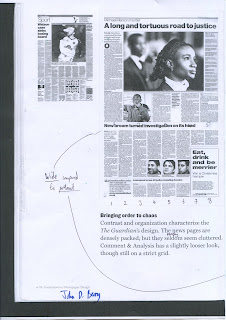Moving forward from my research and feedback, I looked into Newspaper design to gain a better understanding of newspaper format as well as how they communicate the topics.
Sourced some books from the Library:
The Best of Newspaper Design - Twenty First Edition
Showcases designs in the newspaper industry for 1999 created by The Society for News Design.
Section of the book compares The Guardian with Comment & Analysis:
The book characterises The Guardian as being very effective with contrast and organisation as the pages are densely packed but rarely seem cluttered. Comment and Analysis has a slightly looser look, though there is still clear evidence of a strict grid. I highlighted the grid for Comment & Analysis because I like how the page composition is predominantly portrait, making it easier to digest the information. I discovered 8 columns were used for both papers as a strict guide for the type. I found it harder to establish the horizontal grid lines, however I intend to research further into the grid systems used within newspaper design.
I was drawn to this cover page for Rio de Jineiro's 'O Dia'.
Art Director: Andre Hippertt
Designer: Luisa Bousada
Contemporary style and layout as the copy has been set to surround the image, giving it authority and providing the audience with a focal point on the image. 'ADEUS' is Portuguese for 'Goodbye' which can inform the campaign if it was to go into a global campaign. Combining text and image is extremely important within editorial design.
Newspapers are often perceived to be boring, traditional and very serious, which in a lot of cases they are because the topics they're covering are important, however I found some examples of how newspaper design can be adapted to evoke an experiential/emotional response:
Clear combination of physical artwork combined with the digital for example, 'Mural' from Mexico combines photography with the typography by overlapping and setting the type at an angle. The relationship between text and image is really important to stimulate the audience but also keep it legible. Another example can be found in Morgenvisen Jyllands-Posten as the illustration of a blind at the top of the page and the handle divides the page into two.
Contemporary Newspaper Design: Shaping the News in the Digital Age
2007
John D Berry, Roger Black
The publication compares The Guardian's design before and after it was redesigned:
Before:
After:
Before the rebrand the cover page was very formal and traditional as it used the authoritative serif typeface for the header. The page is very busy and there is an overwhelming amount of text which has stayed the same after the rebrand. The main concern for the rebrand was clearly the use of typography as the Guardian introduced a sans-serif typeface. This triple contrast in weight, form and style made it possible to close up the two words, turning them into a single visual unit. These contrasting typographic styles help to create hierarchy and clarity.
Times Classic
Used due to its traditional values as well as the fact it has a compatible set of display weights. Times provides contrast and delicacy within the display family. I can use these fonts to inform the text use throughout my newspaper.
TYPE SIZES
'Decks' = Amount of lines
The amount of decks of the same typeface equates to the point size. The new design leaves more space before the start of the text.
'The Best of Newspaper Design' also offered illustrations to accompany the articles. I was drawn to David Cowles illustration of Obama as the user can colour in the face like paint-by-numbers:
This would be an engaging feature in my magazine as the user can colour in the image to create an outcome, thus finding something that is lost. After thinking about this concept further, I can potentially create a series of dot-to-dot images of a person/symbol to do with missing people in order to demonstrate finding something that has gone missing.
A word search can also be applied to the newspaper as the user can find words associated with the campaign.

















































